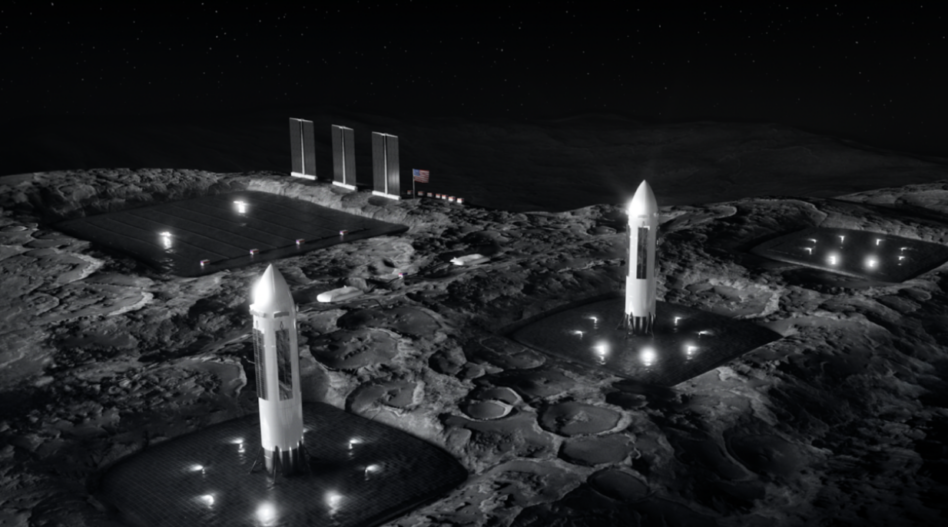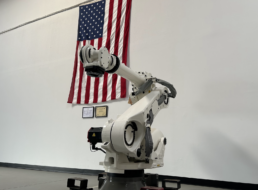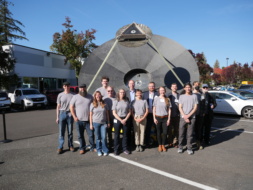If the Apollo era was all about “flags and footprints,” Artemis’ bid for a permanent presence on the Moon will center around lunar infrastructure—the era of “pads and gas pumps.”
Ethos Space Resources, a lunar infrastructure startup with deep ties to SpaceX, emerged from stealth today with plans to tackle this very infrastructure challenge. The company is developing technology to melt lunar regolith, producing both a flat surface for landing and take-off and liquid oxygen (LOX) for rocket propellant.
Two of the company’s three founders were early SpaceX alums who helped build the launch giant’s earliest pads and vehicles.
Ethos founders:
- Ross Centers (CEO): A Colorado School of Mines alum specializing in space resources.
- Jeff Overbeek (COO): A 12-year SpaceX veteran who founded the company’s launch reliability group and helped build Falcon 9 launch sites.
- Brogan BamBrogan (VP of customer ops & integration): BamBrogan was employee #23 at SpaceX, where he helped develop Falcon and Dragon.
In total, Ethos has 14 employees working to make its in-situ lunar resources tech a reality.
“We are starting with the very first infrastructure on the Moon, which is a landing pad, making round trip access to the Moon reliable and affordable,” Centers told Payload. “We will build the pad and liquid oxygen from the lunar regolith to provide a place to land.”
Turning regolith into products:
- When lunar regolith is melted and then resolidifies, it forms a strong, concrete-like material that can be used for a landing and launch pad, the company says.
- During the melting process, the regolith can be electrolyzed to extract oxygen, which would then be liquefied in a cryocooler. Oxygen makes up 45% of lunar rocks by weight.
- The only input in the process is electricity.
Ethos has successfully produced the concrete-like rock in a $2M simulated lunar environment, and has tested the material at its facility under the fiery power of a rocket’s breath. “We were surprised how well it held up. We knew from lab testing that our material was stronger than concrete, but we didn’t know how it would hold up under a hot, violent rocket flame,” Centers said.
The company said that unlike concrete–-which can fracture and throw off big chunks of material—a rocket plume melts the glass and self-heals any fractures.
The Need for Pads and LOX
As both civil and commercial entities plot out long-term missions to the Moon, the potential benefits of lunar pads and locally-produced propellant has been at the forefront of lunar exploration discussions.
Need for Lunar pads: With no atmosphere to break the descent, landing a spacecraft on the cratered and often sloped lunar surface is not for the faint of heart. Two successful lunar landings this year (SLIM and IM-1) were marred by the spacecraft toppling over on landing.
A flat surface would also allow smoother landings and take-offs. The need for a controlled landing environment is particularly relevant for Starship, which has a high center of mass that decreases its stability. Ethos said it also plans on embedding navigational beacons, making a precision landing much easier.
Need for Lunar propellant: Under today’s tech, Moon-bound crewed spacecraft need to carry enough fuel to both land on the Moon and take off from its surface. One Starship HLS could require 10+ refuels in LEO to ensure enough fuel for the round trip—highlighting the tyranny of the rocket equation and the benefits of using a lunar fuel source.
“Mass to the Moon is almost prohibitively expensive right now,” said Centers. “When you’re doing a round trip mass, that’s even more expensive because you have to bring all the fuel to get back to Earth afterward.”
The numbers behind all that propellant:
- Starship second stage dry mass is ~100T…but holds ~1,200 metric tons of propellant, according to public estimates.
- Since Starship’s Raptor engines guzzle an estimated ~20% methane and ~80% liquid oxygen, LOX propellant can be 10x the dry mass of the ship.
Producing LOX from lunar rocks could, in theory, meaningfully improve that pesky rocket equation.
“It is orders of magnitude cheaper to build infrastructure on the Moon using local resources,” said Centers.
Lunar Customers
Founded by two former SpaceX employees to address two critical Starship needs, Ethos’s focus aligns with the success of the Starship HLS program.
“Starship is the most exciting thing that has ever happened in the history of spaceflight,” Centers told Payload.
SpaceX is rapidly advancing its Starship test program, with its fourth flight slated for June 6. However, the timing of a lunar landing and consistent travel to and from our nearest celestial neighbor remains uncertain.
For the greater good: Ethos says it is not just a SpaceX company. “We think that there’s gonna be a great demand for pads—for everybody who’s interested in landing on the Moon,” said Centers.
Other potential customers include Blue Origin’s Blue Moon lander, NASA CLPS customers, and space agencies that may want a flat surface to land to improve the chances of landing their expensive hardware.
Hardware for the Moon
With successful initial tests completed, the company is now looking to scale up and address the unique challenges of performing well 238,900 miles away on the Moon.
Ethos has partnered with Astrolab, a recent awardee of NASA’s lunar terrain contract, to facilitate lunar operations and the mobility needed to build a large pad.
How to build a pad on the Moon:
- Astrolab’s FLEX rover will deploy several power cargo boxes, measuring 1.5 meters by 2 meters, at various locations around the designated lunar pad construction site.
- The rover will tow a heating trailer that melts lunar regolith behind it, harnessing the energy from the deployed power units.
The byproduct is a hardened, concrete-like pad.
As first-movers on lunar infrastructure, the company sees its future offerings expanding into other resource domains like metals, power, and water.




